Usually it takes more than 40.5 hours to get to Lhasa by train, and the first half of the train journey is not as scenic as the second half (Qinghai Tibet Railway). This tour has shortened the long time spend on the train, cut the boring first half’s train journey, and left you enough time to experience the spectacular train life on the Qinghai Tibet Railway. At the same time, it also will take you to explore the best highlights in historical Beijing, beautiful Qinghai and holy Land Tibet.
Highlights of this tour:
- More than 5 world-famous Heritage Sites are waiting for your exploration in Beijing, including Forbidden City, Temple of Heaven, Great Wall, Summer Palace, etc.;
- Visit two of most beautiful lakes in China which are strongly recommended for photographers - Qinghai Lake and Namtso Lake;
- Be immersed in the devoted atmosphere of pilgrimage in the Potala Palace and sacred monasteries – Jokhang Temple, Sera Monastery and Drepung Monastery;
Tour Brief Information
- Tour price: from Request
- Tour code: TD-BXT-11
- Tour Type: Private Customizable Tour Package
- Destination: Beijing / Xining / Lhasa
- Duration: 11 days and 10 nights
- Departure: Flexible
- Travel Theme:





- Best Time:




- Physical Level
- Tour Pace
- Max Altitude
5,068m
- Itinerary Details
- Price Guide & Booking
- Trip FAQs
- Reviews
- Make an Enquiry
Your tour - at a glance
Day 1~4 Arrival & Beijing Tour
Day 5~7 Xining Tour & Train to Lhasa
Day 9~10 Lhasa - Gyantse - Shigatse - Everest - Zhangmu
Day 11 Lhasa Departure
Itinerary Details - Day by Day
Day 1 Beijing Arrival
Welcome to the capital city of China! Upon arriving at the airport/train station, you will be met by your local tour guide, and then drive to your downtown hotel in Beijing City. After the hotel check-in, you are free to take a rest or explore around on your own.
Day 2 Beijing ( B, L )
China has more than 4000 years’ history of Imperial Social System. While Beijing is the best place in China to experience the magnificent history and culture of ancient China. Today your guide will pick you up in the hotel after your breakfast, then start the wonderful ancient China culture and history tour!
You will firstly get to the world's largest plaza – Tian’anmen Sqaure. The grandiose Tianmen Gate was the place where the chairman Mao announced the establishement of the People’s Republic of China to the world. Passing through Tiananmen Gate, you will enter the splendid Forbidden City, the previous home to 24 emperors of Ming and Qing Dynasties for 600 years. Magnificent architectures, intricate ornaments and touching legends make it a must-see of China. In the afternoon, head to visit the stunning and exquisite Summer Palace, and be amazed at the vast ensemble of lakes, gardens, temples, and palaces, together as a masterpiece of Chinese landscape garden design. While in Qing Dynasty, it was the personal summer retreat for the royal families. It is made up of front hill, back hill and Kunming Lake. You will see splendid halls and pavilions in the front hill, while in the back hill, you will enjoy quiet and natural beauty.
After the sightseeing, you will be taken back to your hotel for rest.
-
 Beautiful Imperial Garden in the Forbidden City
Beautiful Imperial Garden in the Forbidden City
-
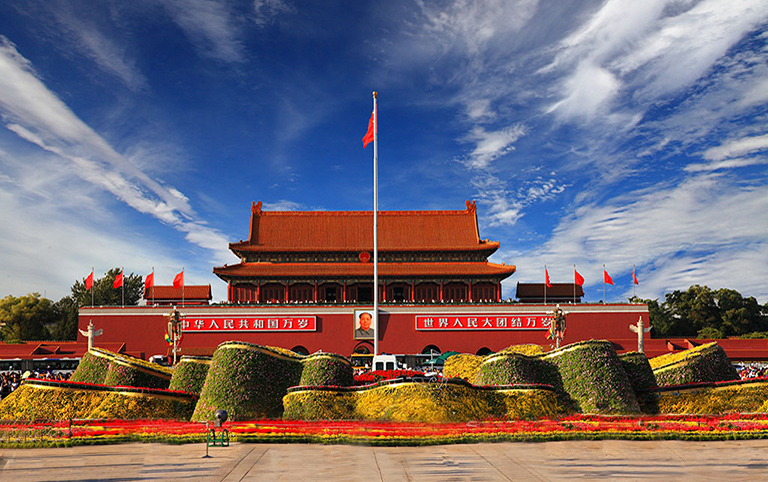 Tiananmen Square is a symbol of national cohesion
Tiananmen Square is a symbol of national cohesion
-
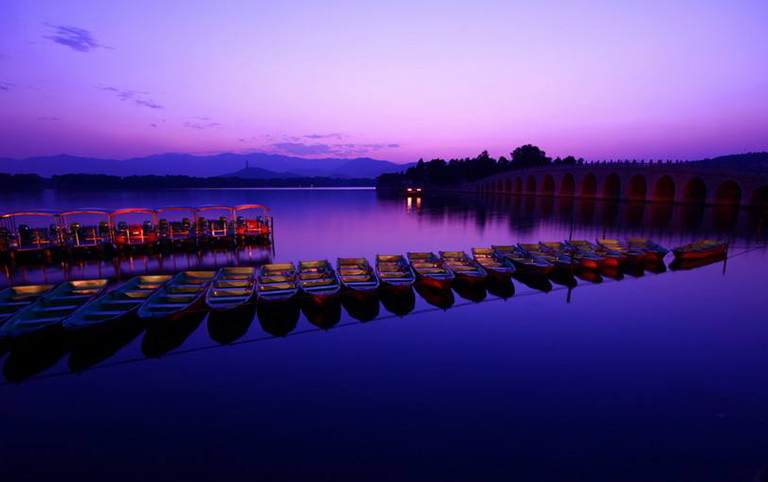 Spectacular Sunset Glow in Summer Palace
Spectacular Sunset Glow in Summer Palace
Day 3 Beijing ( B, L )
Hiking the Great Wall is one-in-a-lifetime thing to do for most travelers. Today, you are going to accomplish the Great Wall dream. You will be escorted about 70km from the downtown Beijing to the world-famous Mutianyu Great Wall which has fewer tourists compared with Badaling Great Wall. At the same time, it is the best Great Wall section to view the delicately beautiful scenery while appreciating the grandness of the Walls. After arriving at the ticket office, you will take a cable car to the walls of Mutianyu, and then hike about 2 hours on the Great Wall.
After the Mutianyu Great Wall hiking, you will drive back to the city. On route, take a sidetrip to the solemn Ming Tombs of ancient emperors in Ming Dynasty. Wander along the Sacred Road, a tranquil royal path featured with statues of divine animals and officials; also take an adventure to the mysterious Underground Palace. Before getting to your hotel, you will also make a stop at the Beijing Olympic Village to take some pictures of the world-famed "Bird’s Nest" and the "Water Cube" from the outside.
-
 Hiking along the Great Wall is a delightful Experience
Hiking along the Great Wall is a delightful Experience
-
 Enjoy the colorful leaves from Mutianyu Great Wall in autumn
Enjoy the colorful leaves from Mutianyu Great Wall in autumn
Day 4 Flight to Xining from Beijing ( B )
After breakfast, you'll go to marvel at one of the greatest masterpiece in Chinese architecture history - the Temple of Heaven, where the ancient emperors used to preside at various rituals for a national good harvest in ancient times. Today, the outer area of the Temple of Heaven is a public park for locals to gather to play Taichi, fly kites, chatting… while the inner area is the historical site for tourists to learn about the ancient Chinese history and culture. Later move on to visit the most famous Hutongs which are some old alleys with traditional architecture originated from Yuan Dynasty (CD 1271~1368. Today, there are still many local Beijingers living in these old quarters, while in the Qing Dynasty (CD 1636~1912), there were even some noble royal families resided here. You can wander leisurely around these narrow alleys to experience the original features of people’s living in old time, or take a relaxing rickshaw through. Lunch will be arranged at a local family. If you like, you can learn to cook some Chinese dumplings by yourself.
After the lunch and say goodbye to the host, the rest time is free untill you are driven to the airport and take the flight to Xining. Our local guide is waiting for you in the airport and you’ll be escorted to your hotel in Xining.
-
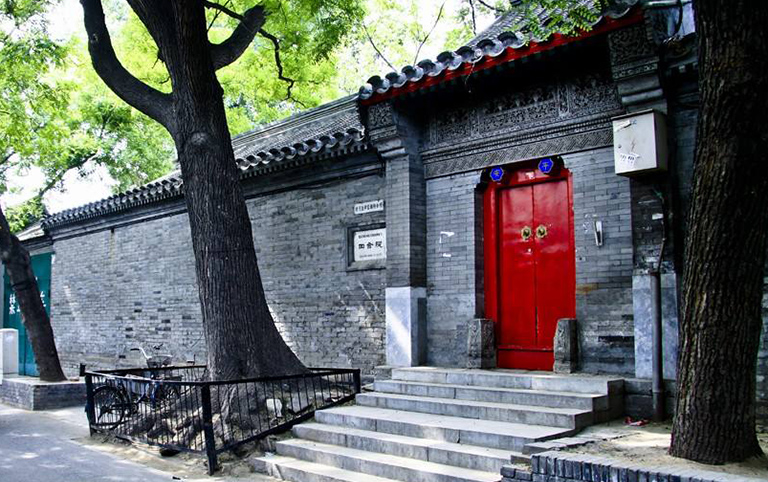
-
 Temple of Heaven is a masterpiece of architecture and landscape design
Temple of Heaven is a masterpiece of architecture and landscape design
Day 5 Xining - Qinghai Lake ( B )
After breakfast, drive around 2.5 hours to the Qinghai Lake which is the best highlights of your Qinghai tour.
Qinghai Lake is surrounded by high mountains from outside. And on the foot of mountains it is endless beautiful grasslands. So you can enjoy the great views by walking, riding or biking. Qinghai Lake is the paradise for birds, which can amount to more than 10 thousand in the summer.
Cruise on the lake and visit the Bird Island in the lake. On route, you will also visit the Riyue Mountains (Sun and Moon Mountains) and the Ri Pagoda and Yue Pagoda which hich were built in Tang Dynasty to commemorate the intermarriage of marrying Princess Wencheng of Tang to Tubo. In nearby, you will also be amazed by the Daotang River which flows oppositely.
Go back to Xining and stay overnight.
-
 Qinghai Lake with Enchanting Natural Beauty
Qinghai Lake with Enchanting Natural Beauty
-
 Full-blown rape flowers resemble a golden wreath on Qinghai Lake (July & August)
Full-blown rape flowers resemble a golden wreath on Qinghai Lake (July & August)
Day 6 Train to Lhasa ( B )
After breakfast, drive about 26km to visit the famous Taer Monastery.
Taer Monastery is the birthplace of the Tibetan Buddhism master – Tsongkhapa who was the founder of Gelug(a sect of Buddhism). It is also famous as one of “Six Gelug Monasteries”. You must not miss the “three bests” of Taer Monastery – murals, barbola and butter sculptures. Taer Monastery is also a very important institute to learn Buddhism, Astronomy and Medicine. There are many Buddhist ceremonies organized here in each year.
Get back to Xining city for the train to Tibet. Enjoy the fantastic plateau views along this highest railway in the world.
-
 Ornate Sculptures Made by Tibetan Butter
Ornate Sculptures Made by Tibetan Butter
Day 7 Lhasa Arrival ( B )
Witness the beautiful Tibetan Plateau with groups of nomads. See the Kekexili Nature Reserve which protects wild plants and animals as well as their natural habitates.
Welcome to the roof of the world! You will be picked up by local tour guide at the airport hall or train station, then be escorted to your hotel in Lhasa city in a private vehicle.
After arrival at your hotel, the rest of the day is free for you to explore the local areas and acclimatize yourself to the air, temperature and high altitude of Lhasa.
High Altitude Acclimation Tips:1) go for some leisure walking to acclimate the high altitude but avoid strenuous activity after arrival; 2) you'd better not have bath, in case of catching a cold; 3) drink more water, and have some fruit; 4) have a good rest.
-
 Wonderful Views along the Railway
Wonderful Views along the Railway
Day 8 Lhasa ( B )
Start today’s Lhasa exploration with an exciting visit to the landmark - Potala Palace which is regarded as one of the most beautiful architectural building in the world. You will climb up the palace along the zigzag stone paths with white-and-red walls to the top of the palace where you can not only appreciate the exotic Tibetan-style architecture, but also get a great view of Lhasa’s urban areas, then walk into the inner space of Potala Palace to explore the stately chapels and learn about the history of the palace.
Continuing your exploration, you will then get to Jokhang Temple which is considered as the spiritual heart of Tibetan Buddhism. Each day, there are thousands of pilgrims coming from different places in Tibet to the temple to worship to the Buddha. This temple is also known as the “house of Buddha” because it keeps the precious Jowo Rinpoche, the life-sized (5 foot/1.5m) image of the Shakyamuni at the age of 12. The last site for today’s exploration is the famous Barkor Street. It is a circular and wide street encircling the Jokhang Temple. The local people like to walk on the street for several circles usually in the late afternoon as a daily tradition of pilgrimage. The street also has many shops selling a wide variety of traditional Tibetan goods, religious items and handcrafts.
Tips of today: 1) there are 1,080 steps up to climb to the top of Potala Palace, so don’t walk in a rush, which may cause high altitude sickness; 2) taking photos is not allowed inside the palace; 3) today you will be mainly outside, please bring some water, a hat, sun cream, and sun glasses with you.
-
 Potala Palace in Spring
Potala Palace in Spring
-
 Jokhang Temple Exterior
Jokhang Temple Exterior
-
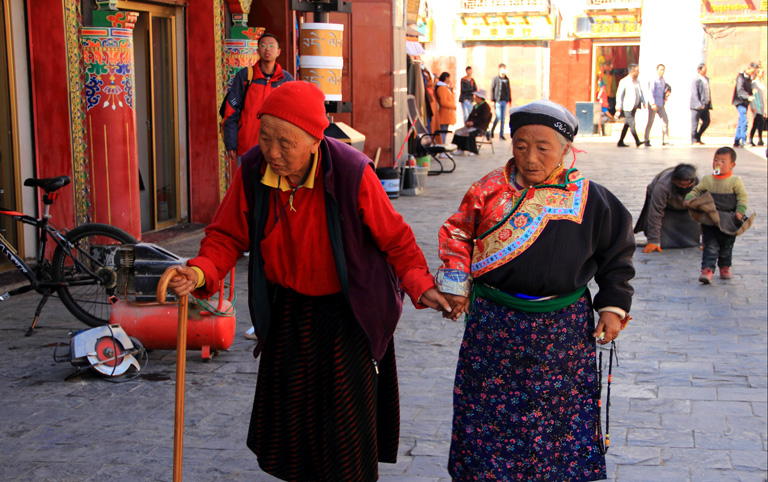 Old Tibetan Women on the Barkhor Street
Old Tibetan Women on the Barkhor Street
Day 9 Lhasa ( B )
After breakfast, you will firstly go to visit the beautiful Norbulingka which used to be the former summer palace of Dalai Lamas in the ancient time, and now is a public park. It is famous for its Potrang, the private palaces of former Dalai lamas with grandiose Tibetan architecture style. Next, drive several kilometers to the western outskirts of Lhasa to visit Drepung Monastery. Drepung, in Tibetan, means “prosperity”. Since its establishment, Drepung Monastery has always been one of the most important Buddhist monasteries in Tibet. In its heyday, there were more than 10,000 monks lived and studied in the monastery. Throughout its history, many important and famous Tibetan leaders used to study here, especially the Dalai Lamas. So Drepung Monastery is also respectfully known as the “Mother School of Dalai Lamas”.
In the afternoon, you will be taken to another famous monastery in Lhasa - Sera Monastery. It is famous for the spectacular “Buddhism Debating”. As a daily routine, the monks gather in a courtyard, and debate on the Buddhist doctrines with supplemented gestures, which is thought to be helpful to facilitates better comprehension of the Buddhist philosophy to attain higher levels of study. After enjoying the "Buddhism Debating", you will be transferred back to the city. The rest time is your own free time to rest.
The Etiquette of Visiting Monastery: 1) you shouldn’t wear short and uncover shoulders; 2) taking off your sunglasses and hat before entering the chapels; 3) taking photos is usually not allowed inside the chapels.
-
 Courtyard for Buddhism Debating in Sera Monastery
Courtyard for Buddhism Debating in Sera Monastery
-
 Grand Buddha Exhibition in Drepung Monastery during Shoton Festival
Grand Buddha Exhibition in Drepung Monastery during Shoton Festival
-
 Pay a visit to the Dalai's Summer Palace - Norbulingka
Pay a visit to the Dalai's Summer Palace - Norbulingka
Day 8 Lhasa – Namtso Lake ( B )
Want to explore some other features of Tibet instead of the monasteries? Let's take an exciting trip to the holy lake Namtso which is about 5 hours driving from Lhasa City. You will arrive at Namtso Lake around the early afternoon. Take some rest and throw yourself into the incredible landscape of holy lake.
Namtso Lake is the highest saltwater lake in the world with an altitude of 4718 meters, also the second largest saltwater lake in China (after the Qinghai Lake). It’s quite common for tourists who are awestruck at the Namtso at the first sight. With the snowy mountains in the background, the crystal-clear dazzling blue water, Namtso is stretching to the horizon. In clear days, the lake looks like a beautiful turquoise surrounded by magnificent snow-capped Tanggula Mountains, and the lakeshore is green, wide and open, dotted with tents, yaks and sheep of local nomads. For travelers, Namtso is the ideal place for photography, while for Tibetans, it is a scared and magical lake for pilgrimage.
Lastly, drive back to Lhasa for accommodation.
Tips of today: 1) the altitudes of Namtso Lake region is about 5, 000 meters, so you should be fully prepared for high altitude sickness. Do remember to keep warm all the time and avoid strenuous activity; 2) if you want to spend longer time and watch sunset and sunrise, you can also accommodate at Namtso for a night, but the accommodation condition is very basic, so is the food supply.
-
 Namtso Lake Yak
Namtso Lake Yak
-
 Local Tibetan Family Woman and Kid at Namtso Lake
Local Tibetan Family Woman and Kid at Namtso Lake
Day 11 Lhasa Departure ( B )
Today is free for you until your tour guide transfer you to the airport in time for your flight or drop you off at Lhasa train station.
Tips of Today: 1) please pack your luggage carefully, especially for small things like camera charger, power adaptor, mobile phone, phone charger, wallet and towel; 2) if your flight is arranged in the afternoon, please make sure you check out the hotel before 12pm.
Useful Trip Notes
-
- 1. Tibet Permits Guaranteed
To travel in Tibet, all Non-Chinese passport holders need to have a Tibet Travel Permit which is issued by Tibet Tourism Bureau in Lhasa. And only Chinese travel agencies like Tibet Discovery can apply for the permit on behalf of tourists. You must obtain it before your tour starting because the permit will be checked when you board your flight/train to Tibet. Traveling with Tibet Discovery, you don't have to worry about the complicated procedures of Tibet Travel Permit application. All you have to do is to confirm a tour package with us and send us your passport and Chinese visa copies at least 15~20 days in advance before your tour, then we will take care of all the rest things. Once the permit is issued, we will deliver to your address in China, such as your hotel, local travel agency, etc.
-
- 2. Available Months to Visit Tibet
Generally speaking, April to October is the best time. July and August are the peak season and rainy season. It is usually snowy and cold in winter, which is not suitable for visit Mount Everest, Namtso and Mount Kailash regions. While other places such as Lhasa, Gyantse and Shigatse are suitable for travel all year around. The temperatures in daytime and night differs a lot, usually 5~15℃ in the daytime and -5~0℃ in the night, so please wear accordingly.
-
- 3. High Altitude Sickness
The average altitude of Tibet is about 4000 meters above the sea level (Lhasa: 3700m; EBC: 5200m; Namtso: 4718m). You may suffer a bit from High Altitude Sickness in the beginning days of your Tibet trip if you haven’t had rich high plateau travel experience. But don’t worry too much, the high altitude can be acclimatized usually in 2~3 days. Our suggestion is to take a physical examination and get suggestions from your doctor, and also bring some medicines to prevent from High Altitude Sickness before your trip. While in Tibet, you should keep warm all the time, avoid strenuous activities, drink more water and eat more vegetables and carbohydrates. You’d better not take showers during the first two days after your arrival in Tibet. If you don’t feel well, get help from your tour guide or go to the hospital without any delay.
-
- 4. How to Go to Tibet
Basically you have two options – flight and train. Currently, you can take a flight to Lhasa from Beijing(4.5hrs), Xian(3.7hrs), Chengdu(2.5hrs), Chongqing(3hrs), Kunming(3hrs), Kathmandu (1.5hrs), etc. Among all these cities, Chengdu and Xian have more frequent flights to Lhasa.
If you prefer a train travel, you can take a train to Tibet from Beijing(40.5hrs), Xian(32hrs), Chengdu(43hrs), Shanghai(47hrs), Chongqing(42hrs), Lanzhou(25hrs), Xining(22hrs), Guangzhou(54hrs). -
- 5. Packing and Wearing Ideas
Firstly you can’t forget your passport and Chinese Visa. A large backpack and a smaller one are recommended (the smaller one can be used for daily activities). Also bring necessary medicine you need. Other stuffs like sunglasses, snow glasses, hats, lip balm, sun block are recommended.
As for wearing, you are suggested to dress in layers (both thin and thick jackets). Down jacket is necessary in Spring and Autumn. A pair of durable and comfortable shoes is necessary.
Recommended Tibet Group Tour Packages
Escorted by a skilled driver and companied by a professional local tour guide to organize all the activities, all you have to do is to enjoy your fantastic Tibet journey.Following are some other recommended Tibet group tour packages that you may be interested in. You can also contact us to customize a trip if you want..
-

Beijing / Lhasa
8 Days to See the Harsh Contrasts of Beijing and Tibet
Highlights: Forbidden City, Great Wall, Potala Palace, Barkhor Street
-

Beijing / Lhasa
8 Days Lhasa Tour from Beijing by Train
Highlights: Forbidden City, Great Wall, Potala Palace, Sera Monastery
-

Beijing / Lhasa
4 Days Lhasa Tour from Beijing by Flight
Highlights: Potala Palace, Jokhang Temple, Sera Monastery




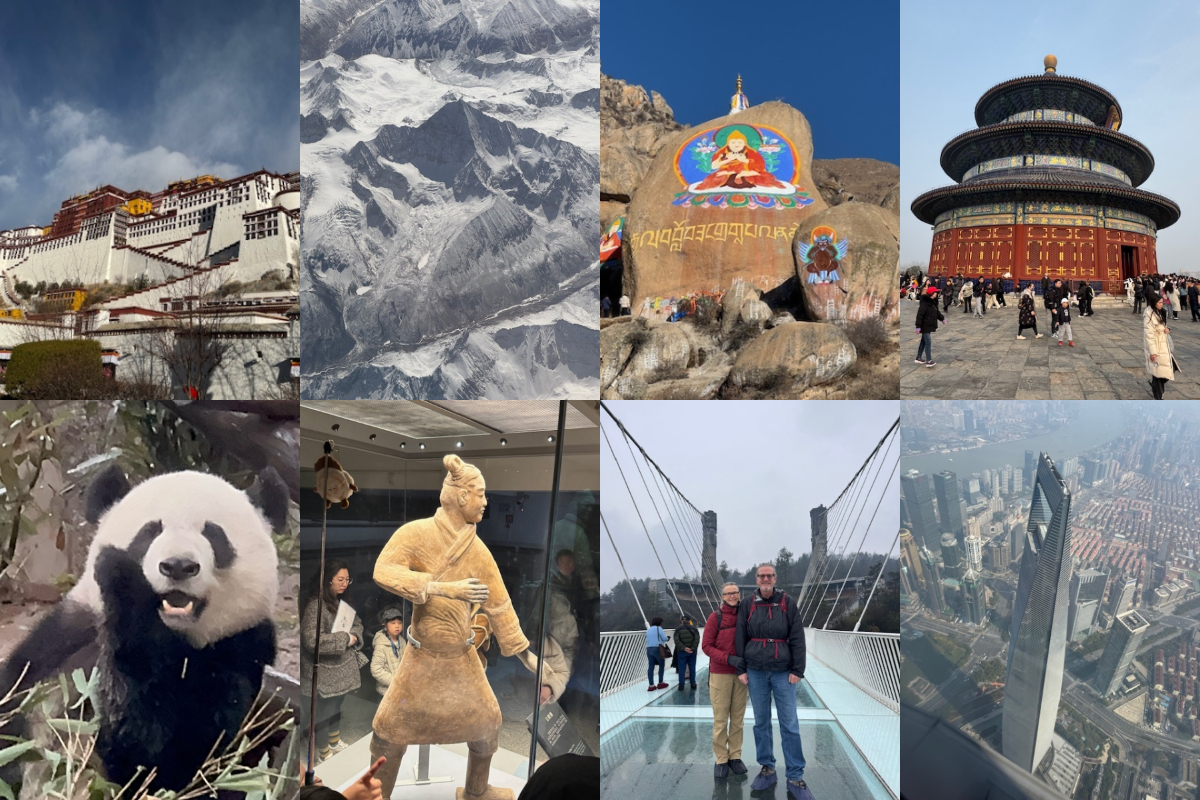


 Karen
Karen Wonder
Wonder Jack
Jack Rita
Rita Johnson
Johnson Vivien
Vivien Wing
Wing Ariel
Ariel Leo
Leo Tracy
Tracy Evelyn
Evelyn April
April Phoebe
Phoebe Kelly
Kelly Shirley
Shirley Reya
Reya Juliet
Juliet Elk
Elk Felix
Felix Sean
Sean